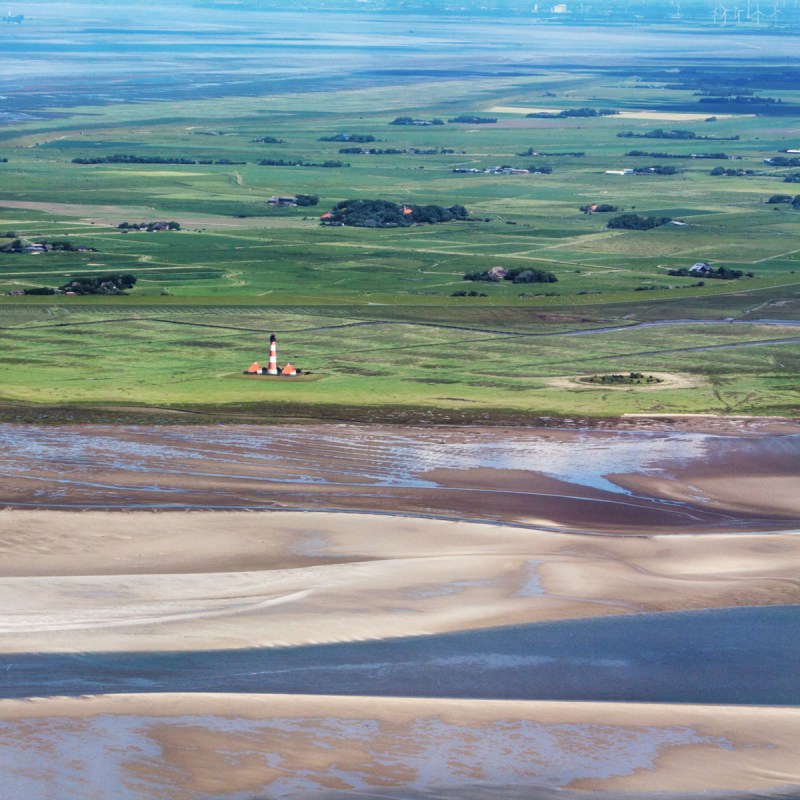
Germany’s North Sea Coast is lined with two island groups: the North Frisian and the East Frisian Islands. There are seven inhabited East Frisian Islands and four larger North Frisian Islands, plus over 10 islets — which are called Halligen — some with just one cottage on it.
Videos by TravelAwaits
Each of the islands has individual characteristics and features of geography as well as attractions and activities they are best known for.
The islands are interconnected by frequent ferry services, and international airports are on the mainland in Hamburg and Bremen. From there, ferries also run to the various islands in the group. The North Frisian Island of Sylt can also be reached by air or train. Sylt is one of the few islands where cars are allowed, so you can bring yours on the train that runs over a causeway from Niebull.
North Sea Islands like Borkum and Norderney are popular because of the beneficial iodine and salt-saturated air which helps with many respiratory ailments. Another fascinating characteristic is the Wattenmeer (Wadden Sea) with its sea life, out of which many of the islands grow, and the many walking tours that explore this unique natural habitat of birds and fish. Germany’s North Sea Coast is a UNESCO World Natural Heritage Site.

1. Walk The Bottom Of The Sea On Borkum
Borkum is the largest of the East Frisian Islands and best reached by a 2-hour ferry ride from Emden in East Friesland. Borkum, apart from huge sand dunes and three lighthouses, is famous for being one of the best places to undertake extensive hikes “on the bottom of the sea,” which means exploring the Wadden Sea. The Wadden Sea is the world’s largest tidal flats system. It extends along the North Sea coastline of three countries: Germany, Netherlands, and Denmark. All three are committed to protecting and preserving this unique habitat for sea life and migratory birds as well as rare plants and a seal colony.
Twice a day, the sea retreats, exposing miles of the sandy sea bottom, interspersed with fields of reed, small water pools, and rivers called siels — populated with cockles, shrimp, and the multitude of birds hunting for food. One of the most exciting experiences is to embark on a wattwanderung, a hike across the Wadden Sea.
Pro Tip: Never ever venture out on your own. Many an unfortunate tourist has drowned because they didn’t realize how fast the tide turns and floods the Wadden Sea, cutting them off from safe land. A great guide from the island of Borkum is Johann. He also conducts walks to the islands of Baltrum and Norderney.
2. Beach Life, Frisian Style
All of the German North Sea Islands are blessed with long, white sand beaches. But, they aren’t just flat stretches of sand, they are particularity huge dunes. The best ones are to be found on the islands of Sylt, Juist, Norderney, Langeoog, and Borkum. However, you can’t just walk into the dunes and throw down your towel. They are fragile and only kept in place by reed grass and therefore protected. Many are fenced off or have signs asking visitors not to step on or into them. Find a place where you are allowed to enjoy the dunes, especially the island of Sylt, which has designated such spaces, called Buhne, some even for naturists. It is much better and more fun to rent a cult object of the German North Sea Islands: a strandkorb. This is a hooded and reclinable beach chair, made from wicker, wood, and striped canvas. Hundreds of them are dotting the beaches of every island. They are also more comfortable than just lying flat, as they protect from the strong North Sea winds and the equally strong sun.

3. Stay In A Thatched Island Cottage
You may be used to staying in big hotels on your vacation, but if you want a true German North Sea Island experience, here is a secret tip: head for the island of Pellworm. Located in the middle of Wadden Sea National Park, this island is a heaven of peace and quiet, with plenty of the traditional Frisian reed-roofed cottages where you can find a warm welcome from the locals and a home away from home full of charm and romance. Look at Bibis Hus, as typical a thatched-roof house with a big garden as possible. Ideally located, it features three bedrooms, 2 bathrooms, free WiFi, and is not far from the beach, the lighthouse, and the quaint Rungholt Museum.
You can get to Pellworm from Hamburg by train or bus.

4. Savor Frisian Cuisine
The hearty food of the East Frisian Islands revolves around fish, seafood, meat, and potatoes — and in some dishes, a combination. An example is Labskaus, a nutritious dish which was a regular staple of 18th century seafarers. Granted, it doesn’t look very pretty, but you must taste it at least once; it grows on you. It’s a puree made from corned beef, pickled beetroot, mashed potatoes, and onions, with a fried egg on top and gherkins and herring on the side. A favorite fish dish is Finkenwerder Scholle — pan-fried plaice served in a creamy bacon sauce and boiled potatoes. Smoked fish, like salmon, trout, and mackerel, is found at every good fishmonger and eaten with buttered brown bread.
Have some fun, especially on the islands of Juist and Sylt, where you can buy a paper bag full of freshly harvested shrimp, then sit down on a beach bank, peel them, and pop them in your mouth. Make sure to have plenty of paper napkins to wipe your fingers. This pastime is called Krabbenpulen.
Green beans cooked in salt water with potatoes, chunks of bacon, and sausages are another favorite dish.
Friesland is tea country, the tea is freshly brewed, no tea bags, left to steep until it is very dark, and a dollop of cream is added or a shot of rum.
5. Watch The Seals
The Wadden Sea is home to great colonies of seals. It’s great fun to take a boat trip to the sandbanks in the Wadden Sea where the seals lazily sun themselves before they slip back into the water if they are disturbed or the flood returns. These boat trips from the islands of Borkum, Norderney, Wangerooge, and Greetsiel are very well organized and designed to cause as little disturbance to seals as possible.
If you wonder where abandoned baby seals are being cared for, head to the Seal Sanctuary Nationalpark-Haus Norddeich where they are cared for, raised, and released back into the North Sea. Norddeich is located in the southwest region of East Frisia.

6. Have A Spa Day On Norderney
Norderney is one of the seven inhabited islands of the East Frisian North Sea Coast of Germany. The island has a small, regional airport but is better reached by ferry from other islands or from the mainland of Norddeich near the city of Norden. The entire east half of the island belongs to Wadden Sea National Park. Norddeich is famous for two things: the summer residence of the Kings of Hanover in the 18th and 19th centuries and its beneficial climate for people who suffer from insomnia, stress, and any kind of respiratory problems.
Indulge in a day of healing, relaxation, and fabulous treatments, because Norderney has the largest Thalasso therapy spa in Europe. In fact, everything in the Bade: Haus Norderney revolves around every imaginable Thalasso therapy treatment. Heated pools, cold pools, saltwater pools, waterfalls, saunas, steam rooms, mud baths, massages — you name it and you will find it in the Bade Haus to spend an utterly healing and relaxing day. You can also spend the night in one of their apartments or enjoy a walk along the promenade. Look at the elegant buildings and windmill that date from the times when the island was a royal summer residence, frequented by the rich and famous who also discovered the health benefits of Norderney.

7. Party The Night Away On Sylt
Often dubbed the “Champagne Island,” the North Frisian Island of Sylt has gained a reputation for its animated nightlife and party scene. It’s equally lively during the day, when locals and visitors sun themselves on the endless, white beaches, lounge in the sand dunes where access is allowed, visit the old hippy favorite Buhne 16, and the naturist beaches. Enjoy said champagne, oysters, and lobster in one of the exquisite (and very expensive) restaurants. The luxury reputation came about in the 1960s when German and international celebrities came to the island to vacation, party, or to acquire lavish, reed-roofed cottages.
The island has an airport often used by the aforementioned celebrities to fly in on helicopters. Less affluent people reach the island by train over the Hindenburgdamm from Hamburg or Berlin. They can also transport their car on the train as cars are allowed on Sylt.
A great restaurant in Westerland is Die Alte Friesenstube. Located in the oldest Frisian house, they serve local and very fresh specialties. As for the nightlife, head over to “Whiskey Mile” where bars are open until the early hours of the morning.
If you’re thinking about a trip to Germany, consider these locations:

